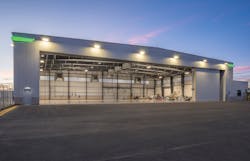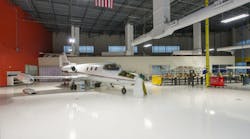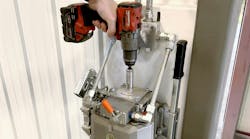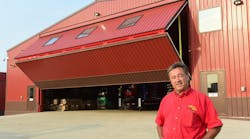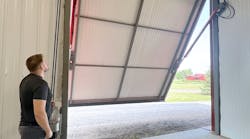According to a recent survey conducted in late September 2020 by Private Jet Card Comparisons, an independent private aviation research website, 51 percent of the respondents are planning to increase their use of private aviation, with 31 percent reporting their companies are expanding usage of private aviation services.
Private jet companies are investigating methods to make charters less expensive through different programs such as fuel card memberships, bulk purchase of flight hours, and fractional ownership. These measures have increased efficiency, impacting the business aviation industry significantly.
As both individual travelers and corporate organizations continue to look for alternatives to commercial airline travel, business aviation support facilities could be looking at a post-pandemic building boom. Map the trajectory here with key insights to strategies to overcome challenges and deliver potential solutions for navigating business aviation planning and design in a post-pandemic world.
Changing Public Perception
The business aviation market sector has long suffered from poor public relation optics, with many perceiving private jet travel as an elite perk for corporate moguls, celebrities, and star athletes. As a result, changing public perception is top priority for the future.
As passengers continue to be concerned about health and safety regulations, combined with commercial airlines now filling middle seats again, businesses are seriously considering investing in aircraft, something they have traditionally avoided due to political/public perception concerns.
In addition, as commercial airlines reduce flights to cut costs, private jets can support direct flights to second and third tier cities alleviating time consuming multiple connections.
Part of the strategy for altering public perception must include leveraging the fact that airports are more than transportation hubs; they are often the “front door” for a city or a gateway to an entire region and are critical to economic development.
In the past, shipping, railway, and later, highway systems played vital roles in determining a city's economic power, much like today’s business air travel is crucial to the growth of second and third tier cities and emerging regions.
As a result, smaller airports and individual hangar facilities feature conferencing facilities where local politicians and economic development staff can host and welcome search committees looking for their next big box retail location or manufacturing plant and serve as the places where “deals are made.”
Based on these factors the infrastructure to support business aviation – such as new and modern fixed-base operations and corporate operators at regional airports with maintenance accessibility and hangars to store the aircraft – is becoming increasingly important.
The business aviation operation models fall within one of four groups, each industry with differing needs based on their frequency of use, purpose and revenue stream. As a result, their infrastructure and hangar requirements are unique.
Fixed-Base Operators (FBOs), an integral component of the business aviation community, are located at most airports – from large commercial airports to small town and regional airports – supporting their local aviation community.
These commercial enterprises have typically been granted the right by an airport authority or sponsor to operate at that airport and offer an array of services for customers, aircrafts, and crews. These services may include high end passenger and crew support as well as high tech conference facilities for their customer’s use.
At larger airports serving major cities, there are often several privately owned FBOs in competition for the business of both permanent-based and transient general aviation aircraft.
Their revenue streams come from a variety of sources: fuel sales, ramp fees, aircraft cleaning, deicing, catering and other various services.
However, there is considerable consolidation in this market as single operators or small chains are finding it difficult to compete with the lower fuel prices and amenities larger publicly owned FBO operators can provide due to bulk purchasing of fuel and system wide incentive savings.
Maintenance, Repair and Overhaul Facilities (MROs) is any location, facility, workshop, or hangar that obtains its revenue stream by providing aircraft maintenance. The term "MRO facility" covers a broad swath of the industry, the specific business models and hangar design requirements vary greatly.
Prior to stand-alone MRO facilities, major airlines and air freight carriers owned and managed their MRO facilities. As their fleets expanded, resource expenditures went up. At the same time, low-cost airlines entered the market and relied heavily on independent MROs to provide maintenance, reducing their overhead.
To reduce costs and remain competitive, many major airlines followed suit by also turning to third-party MRO providers. Aircraft maintenance, once considered just a cost of doing business to airlines, has emerged into a competitive business.
Privately Owned Facilities are those hangars and support facilities purpose-built to house and maintain aircraft owned by corporations or private individuals.
The size and cost of these facilities is determined by the type and number of aircraft it will support. These clients consider the facility to be a fixed cost, necessitated to protect the significant investment made in purchasing their aircraft.
Most of these owners use their aircraft primarily for business purposes, although there may be some personal use. What these clients do have in common is discretion. Private and corporate owners require security as well as privacy and do not want to publicize their private jet travel in front of their shareholders, and high-profile celebrities want to be far from the paparazzi’s cameras.
As a result, the exterior design of these facilities may be very low profile, although the interiors may involve spaces created with attention to high levels of design detail. The goal is to offer functional spaces to support the safe, secure and discrete handling of the passengers, crew and aircraft. Most, if not all these clients require non-disclosure agreements before discussing design.
Developer Owned Facilities are a relatively new trend in the industry and these facilities are designed and built from a pure real estate perspective.
The growth in private jet travel, combined with the lack of affordable hangar space at metropolitan, regional, and local airports, helped developers see an opportunity to make profitable investments.
Looking at the business models of FBOs – seeing that it required land for buildings, tarmacs, and gas pumps – many approached the process like big box retail store development, not realizing how much government regulation is involved in hangar design and airport development.
These clients benefit the most from engaging an aviation design expert to help them understand the unique complications of developing on airport leaseholds.
Aviation Facility Design Considerations
While ownership and business use may be different, there are several shared design considerations to be considered when designing aviation support facilities. First and foremost, understanding the function of the facility as a one-size-fits-all is not a successful approach. Secondly, have an open and honest discussion regarding both the construction and operating budget before beginning design. There may be environmental mitigation and jurisdictional requirements with associated costs that may impact the viability of the project. Following, are key aviation project considerations which could significantly impact your hangar design project.
How the facility will be used
A hangar facility is more than just a place to park an aircraft. A corporate hangar may need to be sited with a view of the airport access road so the crew will know when the executive and their entourage is approaching. An FBO hangar should provide a crew lounge with a view of the facility’s port cochere/arrival area to know that their passengers have returned.
A developer driven facility will need to provide enough space to house multiple aircraft without incurring “hangar rash” caused by accidental bumps and scraps against equipment, doors, and other aircraft. Trying to achieve maximum theoretical aircraft density can lead to unsafe and costly operations.
An aviation design specialist is able to design hangars, layout safe ramps, and specify materials based on potential use to help avoid those issues. Certain hangar doors, for example, accommodate more frequent openings and improve the overall efficiency of the facility.
Setting Realistic Project Timelines
Aviation facility design and construction can be a lengthy process, often taking as much as two to four years to complete as a result of dealing with multiple layers of government agencies. Subsequently, clients should budget appropriately for these projects.
Building permits can be very difficult to obtain, as many technical issues must be addressed - typically many more than on non-airport property.
Clients must also realize a building permit is only the beginning of the construction process.
Developments may require specialty inspections (i.e. fire suppression, electrical, structural) or review by other Authorities Having Jurisdiction (AHJ) during the construction process that may impact the completion date.
An experienced aviation design company will make clients aware of these potential speed bumps, helping to alleviate unforeseen issues and associated project costs once the project is well underway.
Map your Trajectory
As with any project, experience matters. This is especially true in aviation facility and hangar design because understanding potential project pitfalls early in the process can make or break a project.
The more completely the trajectory for these projects is mapped out regarding location, building function, permits, regulatory code compliance and approvals, the more likely a project will provide a positive return on investment.
Having design and engineering expertise brings experience in all facets of aviation facility development operations and will Help position you for a wholly successful project.
W. Mercer Dye is President of DYE | NBA AVIATION ARCHITECTURE LLC. He can be reached at [email protected] or 770.331.9018.
Cannon Reynolds, AIA, LEED AP, is Managing Director Architecture, Atlanta, with Niles Bolton Associates. He can be reached at [email protected] or 404.365.7600.
